Impact of Different LEED Versions for Green Building Certification and Energy Efficiency Rating System: A Multifamily Midrise Case Study
Document Type
Article
Publication Date
11-1-2017
Publication Source
Applied Energy
Abstract
Various versions of the Leadership in Energy and Environmental Design (LEED®) have been introduced with the addition of more stringent sustainability parameters and credit scoring schemes over the past decade. Such changes in LEED versions strongly affect the energy performance and LEED scores of the target building in the LEED certification process. Therefore, to validate and improve the current LEED version, it is crucial to investigate and compare the impact of different LEED versions on the building energy performance and scoring scheme. However, researches comparing the sustainability metrics for mid-rise multi-family buildings are rare. Therefore, this paper investigates the potential changes in the energy performance resulted from applying different LEED versions (i.e., LEED v3 and v4) for the Energy and Atmosphere (EA) category. Towards this end, a case study was carried out with energy modeling and simulation using TRACE 700 to compare the changes in the energy performance of four analysis scenarios applied to an existing mid-rise multi-family building located in Ohio. Results showed notable changes in LEED points when different versions of LEED using different ASHRAE Standards (i.e., ASHRAE Standards 90.1-2007 and 90.1-2010) are applied for the building energy analysis. In particular, mid-rise multi-family buildings could benefit from LEED v4 in terms of LEED credits as the prerequisite for the minimum energy performance improvement in EA category became significantly lenient compared to LEED v3. On the contrary, when the percentage energy performance improvement is over 34%, mid-rise multi-family buildings would benefit from LEED v3 as it becomes difficult to gain more points for similar energy performance improvement in LEED v4 compared to LEED v3. Various stakeholders including USGBC and government can benefit from using the key findings of this study for improving the LEED certification and national energy standards.
Inclusive pages
732-740
ISBN/ISSN
0306-2619
Copyright
Copyright © 2017, Elsevier
Publisher
Elsevier
Volume
205
Peer Reviewed
yes
eCommons Citation
Choi, Jun-Ki; Hong, Taehoon; Lee, Minhyun; and Rastogi, Ankush, "Impact of Different LEED Versions for Green Building Certification and Energy Efficiency Rating System: A Multifamily Midrise Case Study" (2017). Mechanical and Aerospace Engineering Faculty Publications. 206.
https://ecommons.udayton.edu/mee_fac_pub/206
COinS




Comments
Permission documentation on file.